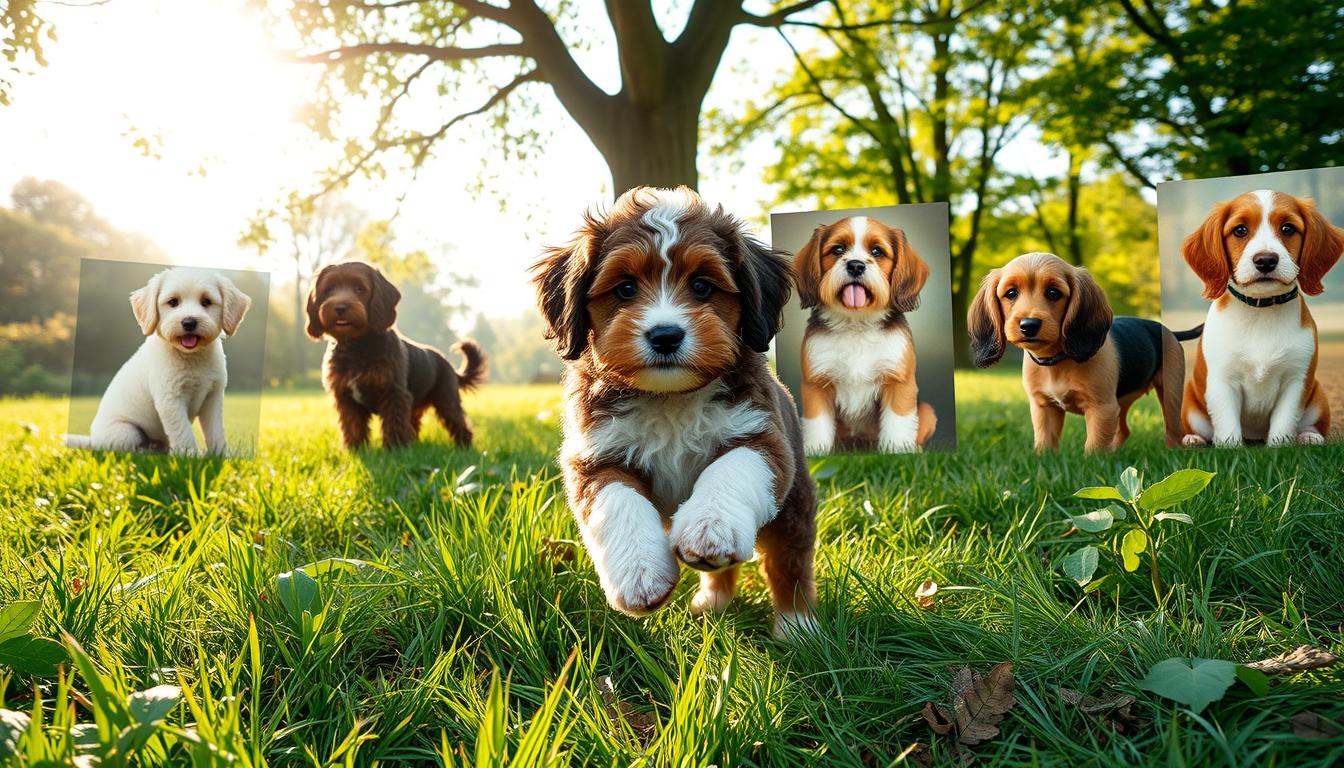Did you know Cocker Spaniels have been around for over 600 years? These beloved dogs first appeared in Chaucer’s works in the 14th century. Their journey from hunting companions to family pets is truly fascinating.
Their ancestry goes back to ancient spaniels, making them one of the oldest dog breeds. Their name comes from their skill in hunting woodcocks. As you learn more about spaniel history, you’ll see they played big roles, even influencing events like Henry VIII’s split from the Catholic Church.
In the 20th century, Cocker Spaniels became even more popular. Today, they are cherished family pets worldwide. Exploring their origins and history shows a breed that has kept its loving nature while adapting to human needs.
Key Takeaways
- Cocker Spaniels have a history dating back over 600 years
- The breed’s name comes from their skill in hunting woodcocks
- Spaniels played roles in significant historical events
- Cocker Spaniels transitioned from hunters to beloved family pets
- The breed gained immense popularity in the 20th century
- Cocker Spaniels are among the oldest recognized dog breeds
Ancient Roots of the Spaniel Family
The spaniel family tree goes back centuries. Spaniel ancestors were key in hunting dog lineage. Their rich history still excites dog lovers today.
Early Mentions in Literature
Spaniels first showed up in written records in the 14th century. Gaston III, Count of Foix, talked about them in his works. This shows their early importance in medieval hunting.
Spanish Roots
The name “spaniel” likely comes from “Hispania,” the Latin name for Spain. Some think these dogs came from Spanish breeds. French hunters called them “Chiens de l’Espagnol,” or “dogs of the Spaniard.” This adds a fascinating layer to their history.
Medieval Hunting Practices
Spaniels were bred to flush game from thick brush. Their role in hunting changed over time. By the late 1600s, they became water and land breeds.
Land spaniels split into setting and springing types. The 17th century brought flintlocks for wing shooting, changing their hunting ways.
Today, Cocker Spaniels are loved all over. They’re the 23rd most popular breed in the United States, according to 2009 AKC stats. Their friendly and smart nature makes them great family pets and working dogs. Their name “Cocker” comes from their skill in hunting woodcock, showing their hunting roots.
The Evolution of Spaniels as Hunting Dogs
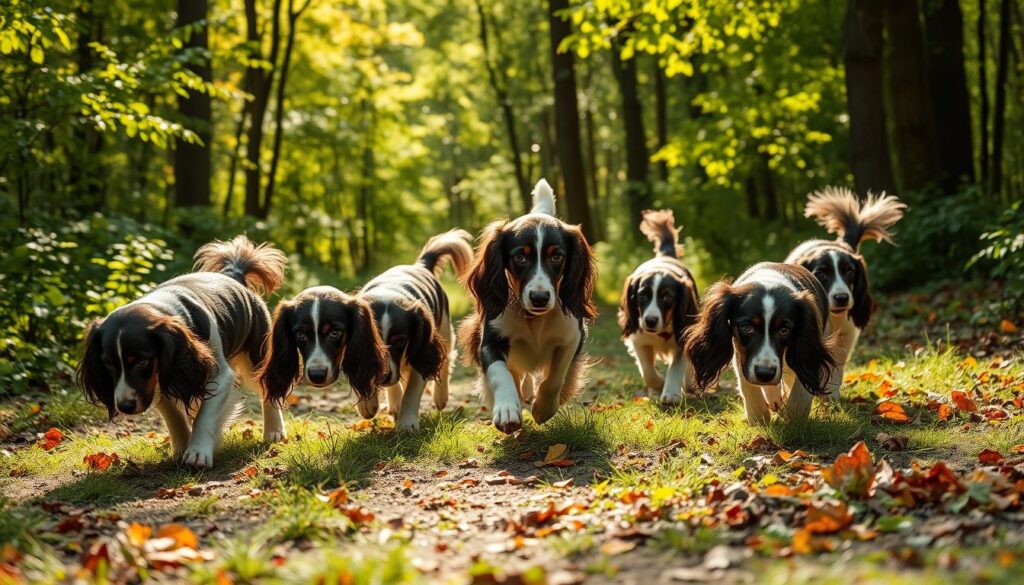
Spaniels have evolved from simple hunting aids to skilled gun dogs. In the 17th century, they became essential for flushing game like pheasants and woodcocks. This made them crucial for hunters.
American hunters valued spaniels for their ability to hunt in different terrains. They could chase game in hayfields or rice stubble. This made hunting more exciting, giving game a fair chance to escape.
Cocker spaniel traits that made them excellent hunting partners include:
- Keen sense of smell
- Agility in dense underbrush
- Soft mouth for retrieving game
- Eagerness to please their handlers
The rise in popularity of spaniels led to the creation of breed-specific clubs and standards. In 1892, the Kennel Club introduced weight classifications. Dogs under 25 lbs were Cockers, great for flushing woodcock. Those over 25 lbs were Springer Spaniels.
Today, many spaniels are cherished family pets, but their hunting instincts are still strong. Breeders like Trish Jackson aim to bring back these traits in American Cocker Spaniels. They focus on qualities similar to English spaniels, improving health and temperament while keeping the hunting spirit alive.
Cocker Spaniel Origins and History
The cocker spaniel breeds have a rich history that spans centuries. These beloved dogs have evolved from skilled hunters to cherished companions. Their origins are deeply rooted in British hunting traditions.
Etymology of “Cocker”
The term “cocker” in cocker spaniel comes from their exceptional skill in hunting woodcocks. This skill made them stand out from other spaniel types. It led to their specialized name and purpose.
19th Century Development
The 19th century was a key time for cocker spaniel history. Before 1892, they were not seen as a distinct breed. Size was the main thing that set them apart from other spaniels.
A spaniel pedigree analysis shows two dogs, Obo (1879) for English Cockers and Obo II for American Cockers, were key. They helped shape the modern breed standards.
Separation from Other Spaniels
As the breed grew, it slowly separated from other spaniel types. This separation became official in 1892 when the British Cocker Spaniel was recognized as its own breed. The American Kennel Club followed in 1946, acknowledging the split between American and English Cocker Spaniels.
Today, cocker spaniels are still popular pets. The British Cocker Spaniel, in particular, has a strong following. Despite health challenges, responsible breeding aims to keep their charming personality and unique look alive. This has captivated dog lovers for generations.
The Birth of the Modern Cocker Spaniel
The mid-19th century was a turning point for the cocker spaniel lineage. Around 1850, breeders started creating the modern Cocker Spaniel. This was a key moment in the breed’s development, leading to the beloved dog we know today.
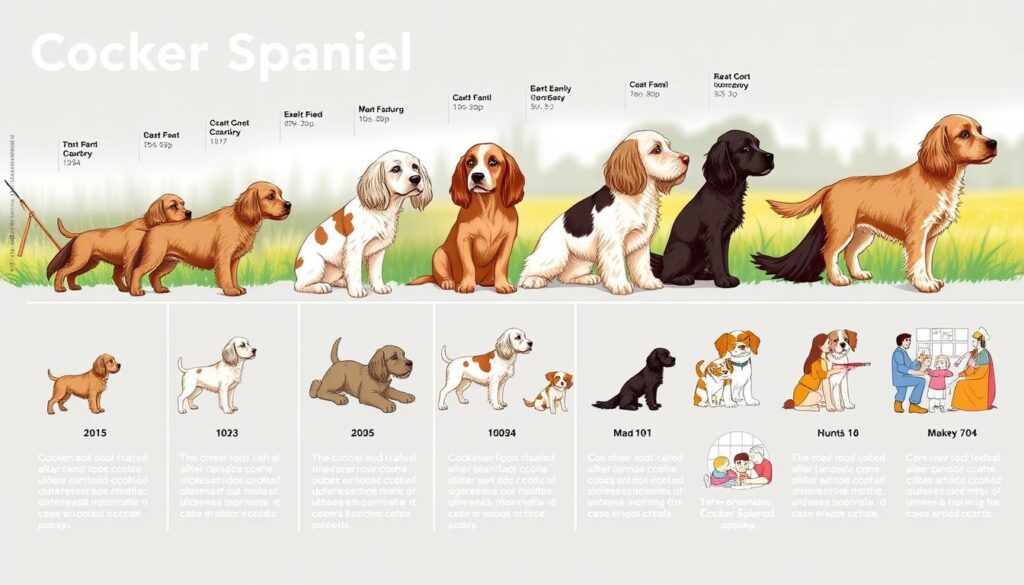
In 1873, the Kennel Club in England recognized the Cocker Spaniel. This recognition made people more interested in improving the breed. Breeders aimed to make a smaller, more agile dog, perfect for hunting woodcock.
A significant figure in cocker spaniel history appeared in 1879. Obo, an English champion, brought consistency to the breed. His son, Obo II, born in America, became the base for the American Cocker Spaniel. This duo was crucial in shaping both English and American varieties.
The late 1880s were a major milestone in cocker spaniel development. Breed registries split Cocker Spaniels from Field Spaniels. This allowed for more focused breeding, refining the Cocker Spaniel’s unique traits.
“The birth of the modern Cocker Spaniel is a testament to dedicated breeding and a clear vision for the breed’s future.”
The field spaniel connection was clear in the Cocker’s hunting skills. Despite being smaller, Cockers were agile and had a keen nose. This made them great companions in the field, adding to their popularity.
Divergence: American and English Cocker Spaniels
The cocker spaniel breeds have split into two types: the American Cocker Spaniel and the English Cocker Spaniel. These dogs share a common past but have grown apart. They now have their own special traits.
Physical Differences
The American Cocker Spaniel is smaller, standing 13.5-15.5 inches tall and weighing 20-30 pounds. Its English cousin is bigger, reaching 15-17 inches in height and 26-34 pounds in weight. The American has a more rounded head and shorter muzzle. The English Cocker Spaniel has a longer muzzle and narrower head.
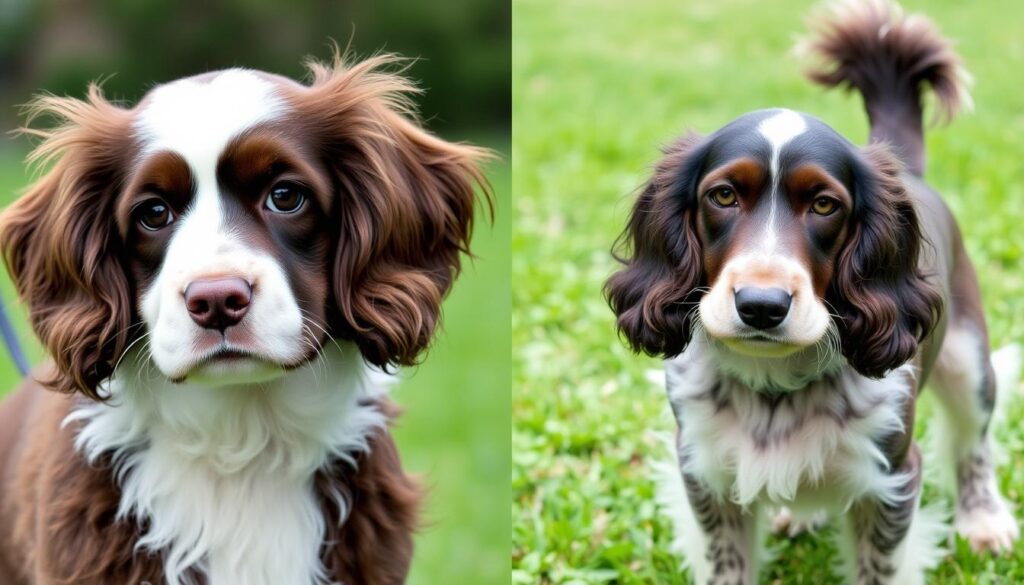
Breeding Goals and Standards
In America, breeders aimed for a stylish look in the American Cocker Spaniel. This led to a dog with a domed head, shorter muzzle, and thicker coat. The English Cocker Spaniel kept its original hunting look and skills.
| Characteristic | American Cocker Spaniel | English Cocker Spaniel |
|---|---|---|
| Height | 13.5-15.5 inches | 15-17 inches |
| Weight | 20-30 pounds | 26-34 pounds |
| Exercise Needs | 1+ hour daily | 2+ hours daily |
| Grooming Needs | High | Moderate |
Recognition as Separate Breeds
The American Kennel Club recognized the American Cocker Spaniel as a unique breed in 1946. This move highlighted the American variety’s special features. The UK Kennel Club followed in 1970, noting the differences between the two breeds.
The Rise to Popularity: Cocker Spaniels in the 20th Century
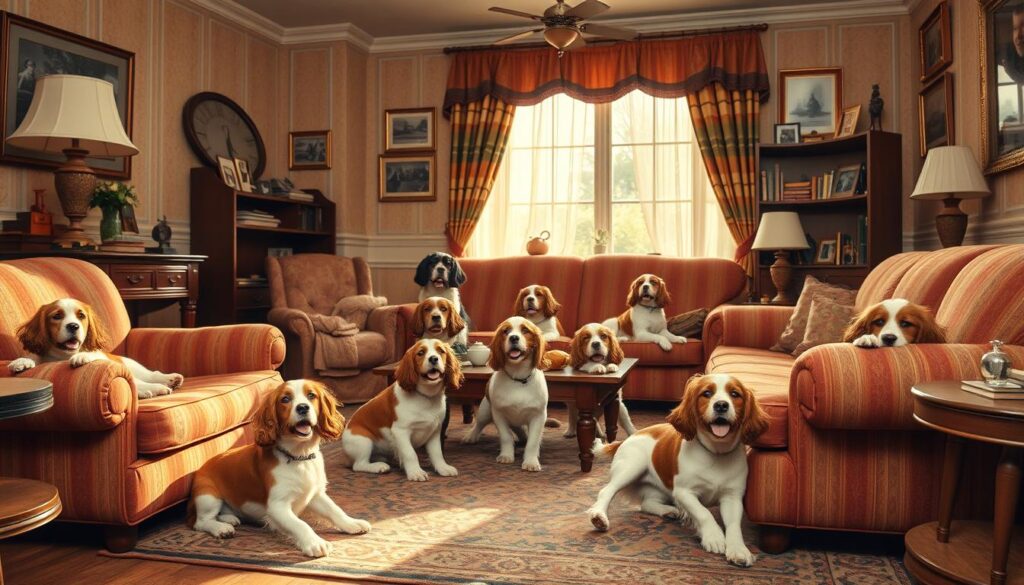
The 20th century was a big time for cocker spaniels. These dogs, with their long history, won over many dog lovers in America. They were the favorite breed from 1936 to 1952 and again from 1983 to 1990.
In Australia, cocker spaniels were a hit at dog shows. In 1910, they made up 12% of all entries. By 1948, 187 of them were in dog shows, showing their wide appeal. Even during World War II, they remained popular in shows.
Their history goes back to Wales and Devon, where they hunted woodcocks. In 1892, the Kennel Club of England recognized them as a breed. Their versatility and recognition helped make them more popular.
| Year | Achievement |
|---|---|
| 1930 | First Crufts Best in Show win |
| 1996 | Most recent Crufts Best in Show win |
| Present | Third most popular breed in UK |
Today, over 20,000 cocker spaniels are registered in the UK each year. They are the third most popular breed, after Labradors and French Bulldogs. Their charm and adaptability keep winning hearts, making them beloved worldwide.
Famous Cocker Spaniels in History and Pop Culture
Cocker spaniels have made a big impact on history and pop culture. These dogs have won many hearts, both in and out of the show ring. They are famous cocker spaniels that many people love.
Notable Show Champions
Cocker spaniel champions have shined in big dog shows. At Crufts, they’ve won the “Best in Show” title seven times. In the U.S., “My Own Brucie” was a star, winning Best in Show at Westminster in 1940 and 1941.
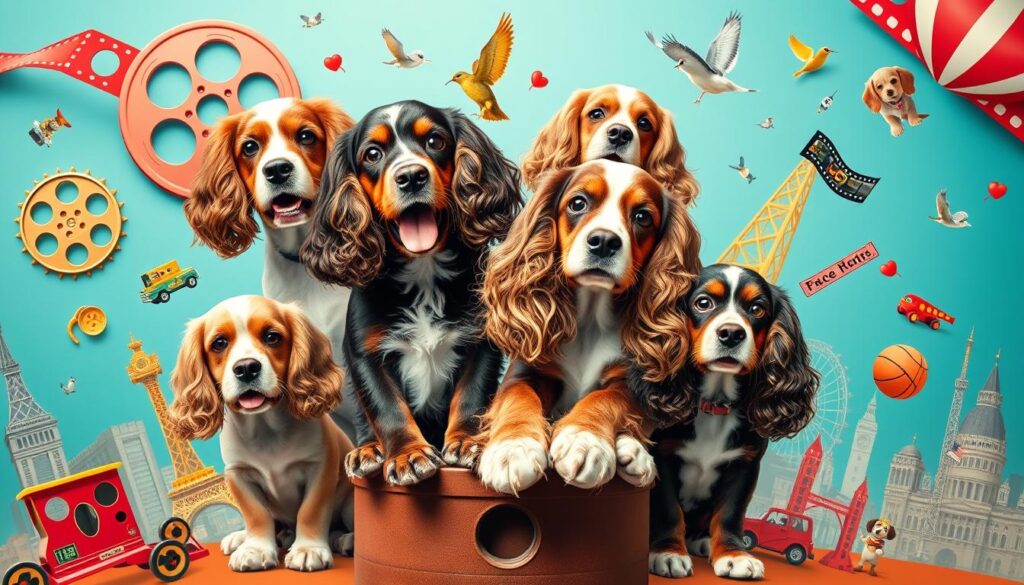
Cockers in Literature and Film
The cocker spaniel has been a favorite in media. Elizabeth Barrett Browning wrote a poem about her cocker spaniel “Flush.” In film, the breed was in Disney’s 1955 hit “Lady and the Tramp,” making it a popular culture icon.
| Medium | Famous Cocker Spaniel | Work |
|---|---|---|
| Literature | Flush | Poem by Elizabeth Barrett Browning |
| Film | Lady | “Lady and the Tramp” (1955) |
| Dog Shows | My Own Brucie | Westminster Best in Show (1940, 1941) |
These famous cocker spaniels have not only entertained but also made the breed more popular. In the 1950s, cocker spaniels were at their peak in the U.S. This shows their charm and versatility.
The Cocker Spaniel’s Transition from Hunter to Companion
The Cocker Spaniel’s journey from hunter to beloved pet is a fascinating tale of adaptation. In the late 19th century, these dogs were bred for hunting. Their keen sense of smell and compact size made them perfect for flushing out game birds from dense underbrush.
As the 20th century dawned, the cocker spaniel’s characteristics began to shift. Breeders aimed for a smaller, more elegant dog with a silkier coat. This change led to a decrease in height by 1 to 2 inches and a lighter weight. They became more suitable as household pets.
The spaniel temperament played a crucial role in their transition. Known for their friendly, energetic, and fun-loving nature, cocker spaniels quickly became popular family companions. Their adaptability and manageable size made them ideal for both urban and rural homes.
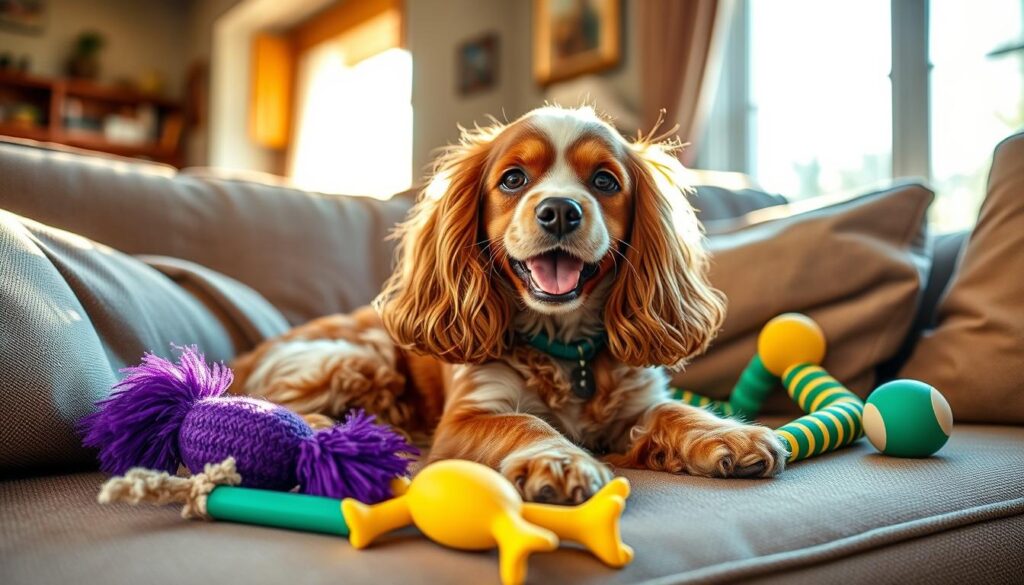
The rise of cocker spaniels as pets coincided with their recognition as distinct breeds. In 1935, the English Cocker Spaniel Club of America formed, focusing on preserving the “English” type. By 1946, the American Kennel Club officially recognized the English Cocker Spaniel as a separate breed from its American counterpart.
| Year | Event |
|---|---|
| 1870s | English Cocker Spaniels brought to America and Canada |
| 1920s-1930s | Breed undergoes changes in conformation |
| 1935 | English Cocker Spaniel Club of America formed |
| 1946 | American Kennel Club recognizes English Cocker Spaniel as distinct breed |
Today, cocker spaniels are cherished more for their companionship than their hunting abilities. Their gentle nature and affectionate demeanor have secured their place as one of the most popular breeds for families seeking a loving and loyal pet.
Breed Standards and Recognition
The cocker spaniel breed has changed a lot since it started. Kennel clubs were key in making the breed what it is today. In 1892, the Kennel Club in the UK recognized the Cocker Spaniel as its own breed. This was the start of more changes in breed standards and types.
The American Kennel Club also recognized the breed, but with a twist. In 1946, they recognized American and English cocker spaniel types separately. This showed the growing differences between them.
Breed standards outline what’s ideal for both types of cocker spaniels. These standards guide breeding and judging in shows. Let’s look at some important points of the American Cocker Spaniel standard:
| Characteristic | Standard |
|---|---|
| Height | 13 to 15 inches at the shoulder |
| Weight | 20 to 30 pounds |
| Lifespan | 12 to 15 years |
| Temperament | Friendly, affectionate, playful, gentle |
The American Cocker Spaniel is a bit smaller than the English one. This size difference was one reason for the breed’s split in 1947. In the U.S., “Cocker Spaniel” means American, while “English Cocker Spaniel” is used for the English type.
Health Concerns and Breeding Practices
Cocker spaniel health is a big deal for fans and clubs. Their popularity led to bad breeding, causing health problems. It’s key to know these issues to keep the breed healthy.
Common Genetic Issues
American Cocker Spaniels deal with health issues like hip dysplasia and eye problems. They also get ear infections and allergies. With the right care, they can live 12 to 15 years.
Responsible Breeding Initiatives
Good breeding is vital to fix these health problems. Breeders now test for genes and choose wisely. They also check for hip and eye health regularly.
Impact of Popularity on Breed Health
The American Cocker Spaniel became famous after winning dog shows in 1940 and 1941. This fame led to bad breeding, hurting the breed’s health. Now, clubs and breeders aim to improve the breed’s health and spirit.
| Health Issue | Estimated Treatment Cost (UK) |
|---|---|
| Ear Infections | £50 – £200 per episode |
| Hip Dysplasia | £800 – £4,000+ |
| Dental Cleanings | £50 – £800+ |
| Pancreatitis | £300 – £1,500+ |
| Dry Eye | £100 – £500 |
By focusing on cocker spaniel health through good breeding, we can keep these pets healthy and lively for years.
The Cocker Spaniel in Competition
Cocker spaniel shows have been a big part of dog competitions for over a century. The American Spaniel Club (ASC) was founded in 1881. It was the first club in the U.S. dedicated to this breed.
The mid-20th century saw a huge rise in cocker spaniel popularity in shows. By 1947, they were the most registered breed in the U.S. This led to the creation of 21 regional clubs in 1946.
Cocker spaniels do well in many competitions. They are great in obedience, agility, hunting tests, and flyball. Their smartness and ability to learn make them top performers.
| Trait | Description |
|---|---|
| Height | Males: 15 inches, Females: 14 inches |
| Weight | 15-30 pounds |
| Coat Type | Double coat, medium-length, silky |
| Lifespan | 12-15 years |
| Registries | AKC (Sporting), UKC (Gun Dog) |
While winning is celebrated, the friendships made are just as important. Charles Born, a former ASC President, said in 2009. He noted that the bonds formed at shows last longer than any win.
Cocker Spaniels in Various Roles
Cocker spaniels are great at many things, showing they’re very adaptable. They’ve moved from being hunting dogs to being loved family pets and helpful working dogs.
Hunting Abilities
As spaniel working dogs, cockers still hunt well. They’re quick and can move through dense areas easily. Their energy is impressive for their size, making them great hunting dogs. In the UK, they’re the second most popular gundog, with 23,927 puppies in 2018.
Therapy and Service Dogs
Cocker spaniels are now therapy and service dogs. They’re friendly and love to please, making them perfect for these jobs. They help people by being comforting and supportive, using their smarts and gentle nature.
Family Companions
As pets, cocker spaniels are great with families. They’re loving and fun, fitting into different homes well. They live over 10 years, becoming part of the family for a long time.
| Cocker Spaniel Roles | Key Traits |
|---|---|
| Hunting | Agile, stamina, work in thick cover |
| Therapy/Service | Gentle, intelligent, eager to please |
| Family Pet | Affectionate, adaptable, long-lived |
Cocker spaniels need the right care, no matter their role. Their food should match their activity level, and they need regular vet visits. This helps avoid problems like hypothyroidism and hip dysplasia. With proper care, these dogs do well in all their roles.
Preserving the Breed: Modern Cocker Spaniel Enthusiasts
Cocker spaniel preservation is key in today’s breeding world. Spaniel breed clubs are vital in keeping these dogs healthy and true to their heritage. They focus on breeding responsibly to keep the breed alive and thriving.
American Cocker Spaniels have unique traits that breeders aim to keep:
- Weight range: 15-30 pounds
- Height range: Males 14-16 inches, Females 13-15 inches
- Breed group: Gun Dog Breeds
- Sub-group: Flushing Dogs
Responsible breeders stick to strict rules to keep the breed healthy. They wait until a Cocker Spaniel is at least two years old to breed. Female dogs have litters of 4-7 puppies every six months.
Efforts are being made to bring back the American Cocker Spaniel’s hunting skills. These dogs are great at many things, like hunting, therapy, and performance events. This shows the breed’s adaptability and keeps its heritage alive.
“The American Cocker Spaniel’s revival in field work demonstrates our commitment to preserving the breed’s original purpose while adapting to contemporary needs.”
To fight bad breeding, many spaniel clubs push for adopting from shelters. This helps give Cocker Spaniels a loving home and supports good breeding. It also helps keep the breed healthy and preserved.
Conclusion
The cocker spaniel legacy spans centuries, evolving from skilled hunters to beloved companions. As you look towards the cocker spaniel future, you’ll find a breed that continues to captivate hearts worldwide. With their charming personalities and versatile skills, these dogs have secured their place in homes and hearts across Australia.
The spaniel breed outlook remains positive, with both American and English varieties thriving. AKC’s recognition of the American Cocker Spaniel as a distinct breed in 1946 marked a significant milestone. Today, these pups enjoy an average lifespan of 12 to 15 years, bringing joy to families for over a decade.
As you consider welcoming a Cocker Spaniel into your life, remember their unique needs. Regular vet check-ups are crucial to monitor for common health issues. With proper care and responsible breeding practices, you can help ensure a bright future for these delightful dogs. Whether as family pets, therapy animals, or even cancer-detecting assistants, Cocker Spaniels continue to prove their worth in various roles, solidifying their place in the canine world for years to come.



